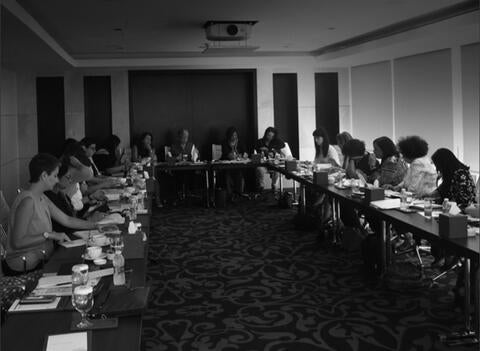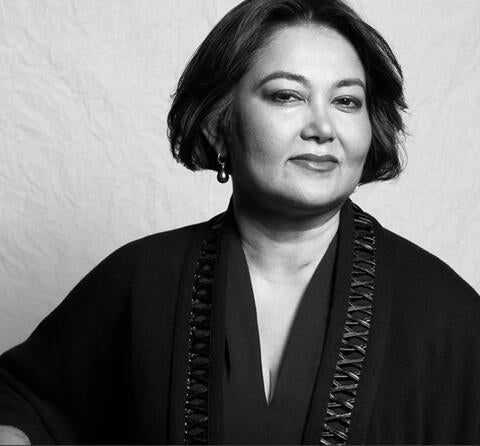
gender-based violence in the context of the Syrian crisis.
Jourdnalists play a fundamental role in amplifying the voices of women and girls and pushing the limitations of silence around issues relating to gender-based violence. This role becomes even more critical during humanitarian emergencies. Since 2014, UNFPA, the United Nations sexual and reproductive health agency, has been directly engaging journalists to address potential shortcomings in the reporting standards at traditional and new media outlets covering the Syria crisis. As of 2018, more than 250 journalists have been reached with these efforts.
In September 2018, the UNFPA Regional Syria Response Hub partnered with the Center for Women’s Global Leadership (CWGL) — a part of Rutgers University in the United States, who initiated the 16 Days of Activism against Gender Based Violence campaign — to host a consultation meeting with journalists in the region covering gender-based violence. The objective of the consultation was to receive insights and feedback from journalists that will feed into the development of a standard-setting, user-friendly tool that will contribute to the professional development of journalists (print, broadcast, and web-based media) reporting on gender-based violence.
After the consultation, we sat with Krishanti Dharmaraj, the Executive Director of CWGL, to discuss the core subjects covered during the consultation. Dharmaraj is a feminist and human rights activist with over 25 years of experience working to advance the rights of women and girls. She is the founder of the Dignity Index, a human rights measurement tool utilized to ensure equity and inclusion to reduce identity-based discrimination. Previously, she was the Western Regional Spokesperson for Amnesty International USA, and she is also the co-founder of WILD for Human Rights (Women’s Institute for Leadership Development) and the Sri Lanka Children’s Fund.
What in your view is the overarching goal of the Center for Women’s Global Leadership?
Drawing on feminist values, the CWGL strengthens and bridges voices for human rights, toward social justice and self-determination. Working at the intersection of gender, human rights and economic policy, the CWGL utilizes an intersectional approach to strengthen the collective impact of its capacity-building, advocacy and thought-leadership activities in efforts to transform civil society.
To this end the CWGL Convenes those closest to the struggle to explore and exchange ideas and solutions; Advocates with, and for, those traditionally excluded from decision-making; and Conducts Research with an action-oriented lens, guided by partners and constituencies around the world who are committed to realizing rights for themselves and others.
We have three primary goals: to achieve substantive equality there by ending gender-based discrimination and violence against women in the world of work; to advance structural reform through the redefinition and measurement of peace and security in order to ensure peace is realized beyond the absence of war; and to amplify feminist thought, standards and leadership to transform civil society and institutions.
Under the above, we globally coordinate two initiatives — the 16 Days campaign to end gender-based violence, which is in over 180 countries among 6000+ groups and organizations, and the Feminist Alliance for Rights (FAR), which currently spans more than 300 regional and national organizations aiming to build a feminist architecture on the ground to shift global policy on women with leadership of the Global South.
Over the span of your career, have you witnessed a substantial shift in public awareness when it comes to gender-based violence? What are the remaining gaps and how do you propose the humanitarian community should address them?
I can speak to this through our 16 Days campaign – it’s only 25 years ago that gender-based violence against women was globally acknowledged as a human rights violation. Since then, the awareness has increased among most, including the public. We have seen many government and international initiatives engaging in increasing awareness.
As for the gaps, systems of accountability for GBV against women still lack political will; they are weak and almost non-existent. Meanwhile, public opinion on GBV against women has shifted only slightly and continues to place blame (directly or indirectly) on the woman. More often than not, GBV against women is not addressed in a comprehensive manner; it is taken out of context and isolated when analyzing and resolving the issue.
It is always important to underscore that because women and girls remain vulnerable and face discrimination and violence in societies at ‘peace,’ they inevitably become the most vulnerable in times of war and conflict along with other marginalized groups and children.

The humanitarian community has a large and a powerful role to play — to ensure all humanitarian responses integrate a gendered approach; to include women at all levels of decision-making and engage them when developing solutions; to combine humanitarian and human rights norms when seeking solutions; to ensure that adequate resources are allocated for services to protect women and other marginalized groups against the vulnerability and violence within humanitarian settings; and to guarantee that those who violate the rights of women in humanitarian settings are held accountable.
What role in your opinion do journalists have to play in combating gender-based violence?
Journalists have a powerful role to play in addressing GBV against women as they are often in a position to shift the public opinion. How they interview a survivor, what they report and how they tell the story can either perpetuate stereotyping of women or transform society by shifting the paradigm.
Tell us about the GBV digital reporting tool currently being developed by CWGL. What inspired this project and what impact do you expect it will have?
Countless participating organizations, institutions and grassroots activists have focused on the structural, legal and attitudinal changes critical to ending GBV around the world. Many have identified the role of the media as being critical to shifting attitudes on violence against women. Similarly, scholars of journalism, researchers and media advocates have increasingly emphasized the importance of language, voice, terminology, semantic choices, and issue-framing in the context of media reporting, government accountability and strategic advocacy around fundamental human rights concerns.
This proposed project to strengthen journalistic coverage of GBVAW stems from a need voiced by participant-activists around the world in CWGL’s 16 Days campaign for a standard-setting guide for journalists on reporting GBVAW. The call for such a tool reflects recognition on the ground that journalistic reporting helps to shape the narrative and perceptions surrounding GBV, which in turn have a crucial impact on how society and policymakers respond.
Why did you decide to partner with UNFPA on this consultation?
Firstly, both CWGL and I personally deeply appreciate how UNFPA has taken on ending GBV as a core objective, and we respect UNFPA for its vision and integrity in advancing the rights of women and girls. The regional media strategy developed by the Regional Syria Response Hub is a forward-thinking initiative that promotes prevention, recognition and results. We found great synergy in our work and are grateful that we could partner.
One of the core topics tackled during this consultation was the protection of female journalists. Why is this topic of particular importance to you?
The role of a journalist is sacred because s/he makes it possible to speak truth to power and provides the space for those most vulnerable to be heard without compromising their dignity.
Unfortunately, this job is now a dangerous one for both women and men. However, due to the gender-based discrimination that penetrates all spheres, the way women journalist face violence is different to men. Like men, they face violence by the state and non-state actors, however they also face harassment and violence to which men are not typically subjected, including physical, sexual and psychological abuse by their colleagues and sometimes at home. They also face discrimination based purely on their gender.
At the moment, we have the opportunity to highlight the protection of journalists — particularly women journalists — through the ILO’s current standard setting process to address harassment and violence against women and men in the world of work. CWGL is engaged in the process and are deeply committed to ensuring the protection of women journalists in the world.
What were the major conclusions and recommendations of this consultation in your opinion?
Every consultation expands our thinking and the convening in Jordan did the same and more. CWGL is engaged in conducting seven consultations with journalists reporting on GBV, five of which will be regional. The consultation in Jordan was our third meeting in this process.
The consultation highlighted how GBV against women in times of conflict is a reflection of how women are treated and portrayed during time of ‘peace,’ further underscoring that a paradigm shift is critical. Moreover, it showed that journalists have a critical role to play in times of conflict or war to highlight these issues, which also stresses the importance of having more women journalists covering stories.
Equally important is to train journalists on how to approach survivors for their stories; after all, speaking truth to power cannot compromise the life and dignity of the survivor. Last but not least, the consultation highlighted the fact that the protection of women journalists is inextricably linked to reporting on GBV against women.


